
Original Link: https://www.anandtech.com/show/1889
Introduction
The NVIDIA GeForce 7800 series has been around for a while now and there's no denying that these are among the most powerful cards available right now. Only recently has ATI released a graphics card that could compete with the mighty 7800 GTX, and though the X1800 XT does compete, current prices still favor NVIDIA over ATI parts in terms of value. This is especially significant given the time of year, as sales, obviously, will be high for both companies, but it's value that will ultimately determine which parts the average consumer will buy.

We've seen some good quality mid-range parts from ATI and NVIDIA lately, like the X800 GTO and the 6800 GS, both of which offer good performance for around or under $200. The X800 GTO in particular at about $170 is an excellent graphics solution from ATI, especially given its overclocking potential. As Christmas gets closer, we will no doubt be seeing deals on other graphics cards as well, and we know many will be hoping for an upgrade under the tree this year.
NVIDIA's 7800 GT is a graphics card that stands out above the majority as being a top performer with competitive prices as well. Today, we'll be looking at three variations of this card: the ASUS Extreme N7800 GT, the XFX GeForce 7800 GT Overclocked, and the EVGA e-GeForce 7800 GT CO. Each of these companies have a reputation for quality, and we'll be comparing them to see how they rate to each other in different areas, such as performance and price. We will also be testing power loads and user-overclocking for each of these cards. The first of these 7800 GTs that we'll be looking at is the ASUS Extreme N7800 GT.
ASUS Extreme N7800 GT

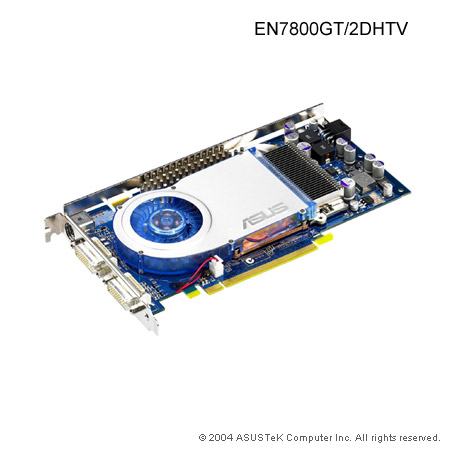

XFX GeForce 7800 GT Overclocked

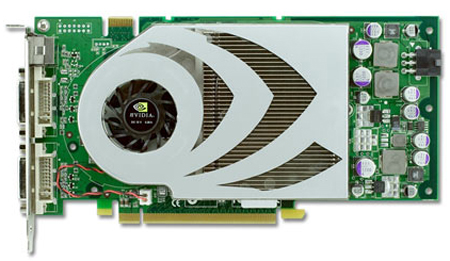

EVGA e-GeForce 7800 GT CO

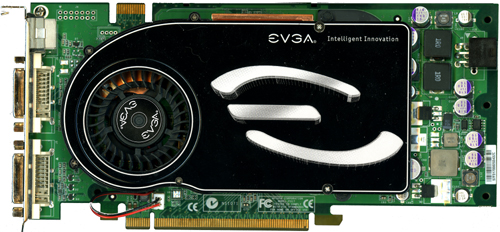

Overclocking/Power Load
We've overclocked a few 7800 GTs in the past, with positive results, and we put each of these three cards to the test for this review. It is important for us to note here that overclocking any graphics card over the factory clock can be hazardous to the card, and also, the results of these tests are subjective. Many times, two cards of the exact same brand and model will have different results when overclocking, but these tests are to give us a general idea of each card's overclocking abilities.
Something that we want to touch on briefly is the issue of scaling frequencies for the 7800, which we first saw when overclocking the 7800 GTX. To recap, because of the way clock frequencies scale for the 7800 GT and GTX, increases in core clock speeds don't always represent actual increases in performance. There are "plateaus" where several consecutive clock speeds (i.e. 468, 469, 470MHz) yield nearly exactly the same performance, and then we see a sudden step up in performance between certain frequencies (i.e. 477MHz, 478MHz ) to create a "stair-like" graph when visualizing the performance scaling. You can take a look at a similar graph and some information about this from a past article here.
To give you an idea of how we overclock our cards beyond their factory speeds, we first use coolbits to detect optimal settings for each card. Then we loop some benchmarks, and lower the clock speeds if we see any graphical tearing or artifacts. A good thing about NVIDIA's overclocking tool is that it will keep the card fairly safe from damage caused by attempting to overclock it too high. We simply use trial and error, raising or lowering the core and memory clock speeds until we find settings that offer the maximum performance while running the tests completely stable.
When we overclocked the ASUS EN7800 GT, which is clocked at reference speeds (400MHz/1.0GHz), we find that it clocks up to 468MHz core and 1.2GHz memory. The XFX 7800 GT OC overclocked to 462MHz and 1.2GHz, not much higher than its own factory overclock. The EVGA e-GeForce 7800 GT had a fairly high overclock, considering that it already came factory OC'ed pretty high: 479MHz core and 1.22GHz memory clock. We ran some Splinter Cell benchmarks to see what kind of framerates would result at the different clock speeds, and here they are for your reference.

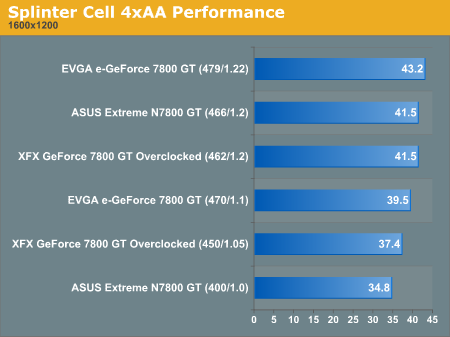
To test the power load of the card, we measure the total watt usage of our test computer at the wall outlet, recording the power usage of our system in two different states. The first state is with the card installed and the computer is idle, and the second is during intensive performance tests (looped Splinter Cell benchmarks). This way, we are able to get a general idea of how the power usage varies between cards.
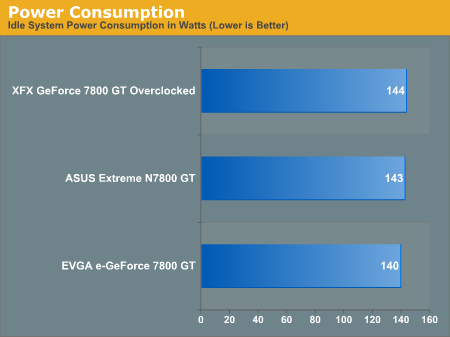
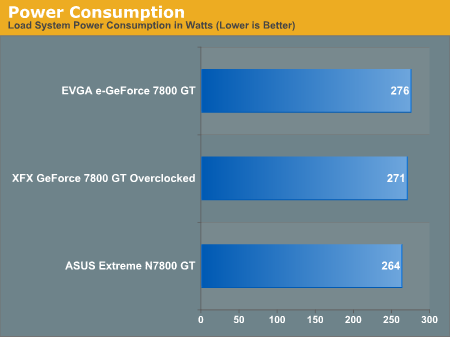
Test Setup/Performance Tests
We ran a number of performance tests with these cards to give us a good idea of how well they perform relative to each other. This lets us see first-hand the actual difference between a reference factory clocked and factory overclocked card. This means that we should see the ASUS numbers slightly lower than XFX's or EVGA's. We tested three games at 1600x1200 resolution with and without AA enabled. The games that we used (Battlefield 2, Quake 4, and Halflife 2: Lost Coast) were chosen because they represent a wide range of game engines. This is the test system that we used:
NVIDIA nForce 4 motherboard
AMD Athlon 64 FX-55 2.6 GHz Processor
1 GB OCZ 2:2:2:6 DDR400 RAM
Seagate 7200.7 120 GB Hard Drive
OCZ 600 W PowerStream Power Supply
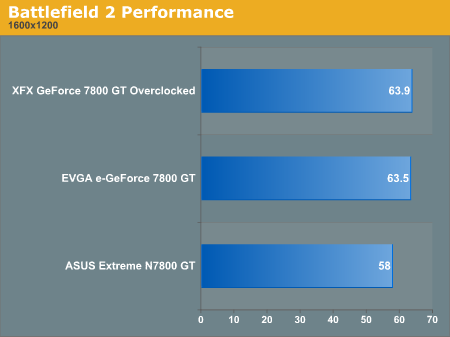
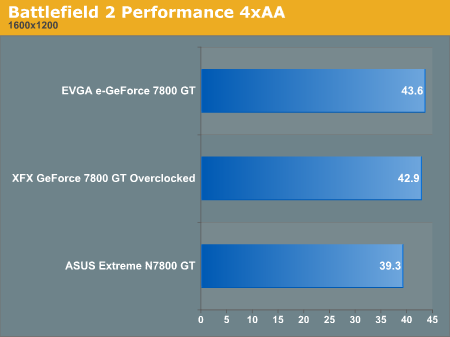
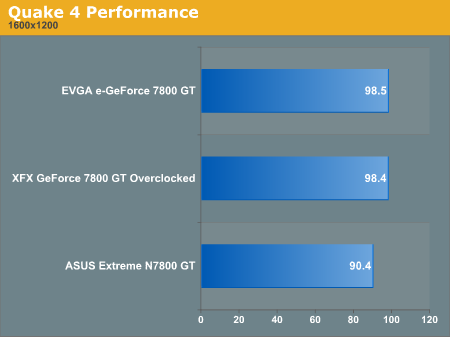

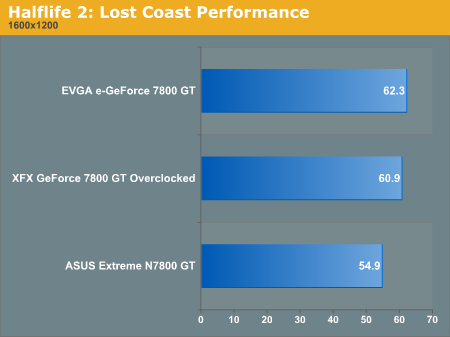
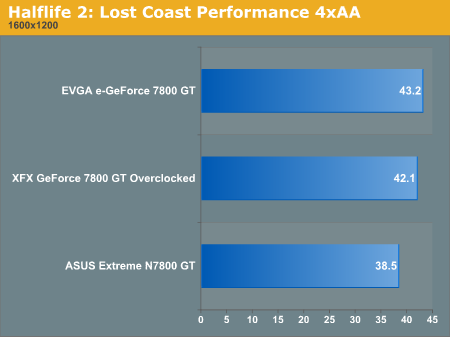
Essentially, what we see in these tests is that the difference in performance between a 7800 GT clocked at reference speeds and factory overclocked to 470MHz/1.1GHz or 450MHz/1.05GHz isn't enough to affect gameplay in a significant way. It's true that you can get a few fps higher in a game with an overclock like this, but it hardly ever makes it worth paying extra money for a card that's factory overclocked, especially when you can easily clock it yourself as high as or even higher than any other card out there. Interestingly though, in the case of these three 7800 GT's, the lowest clocked card (ASUS EN7800 GT) is also the highest priced, and the highest clocked card (EVGA e-GeForce 7800 GT) is the lowest price of the three.
Final Words
We really can't say enough about the 7800 GT. It has proven itself over and over as a top performer among the ranks of 3d graphics solutions. Anyone lucky enough to own one of these cards will attest to its capability of handling any of the most demanding games out now with style. The 7800 GT is still one of the best choices available for those with monitors limited to resolutions of 1600x1200 or lower, and seeing as this is still the case for the majority of PC gamers, sales for the 7800 GT will be high this holiday season.
ATI's X1800 XL does offer comparable performance to the 7800 GT, and is probably its main competition right now in the graphics card market. Prices have been dropping lately for certain ATI products, which is a good thing, and you can find the X1800 XL for as little as $360 at the time of this writing. However, the 7800 GT can be found for as little as $300 right now, and given that the 7800 GT does in fact out-perform the X1800 XL (more or less depending on the game) , the 7800 GT is clearly the better choice. This isn't to say that the X1800 XL is not an excellent video card in its own merit, and we are pleased to see this ATI part at more reasonable prices, given the relatively brief time that it's been available for purchase.
Our performance tests have shown that each of these three 7800 GT's do very well in handling the graphical demands of a variety of games. It can be a difficult thing to sort out where different graphics cards fall performance-wise when looking for an upgrade. It makes it even harder when you have differences in clock speeds between different manufacturer versions of cards of the same type. Many times, a card that is billed as "faster" because of a factory overclock isn't really that much faster as what the manufacturer of the card would have you believe. This is especially true for NVIDIA's 7800 series, given the confusion surrounding the clock scaling frequencies that we've seen in the past.
Sorting out these little differences is enough to give anyone migraines, especially those not very familiar with gaming hardware looking for an upgrade or a gift for someone else. We can say with all confidence that all of these three 7800 GTs are good quality and would please any PC gamer with their performance. That said, these cards are not the same, so let's talk about how they differ for a moment.
Perhaps the biggest factor in distinguishing these cards is their price. The EVGA 7800 GT CO is the cheapest at $300, and the XFX GT is second at $320. The (standard) ASUS 7800 GT is about $380, which doesn't make much sense to us given that it is technically the slowest of these three cards. This fact, in addition to the fact that ASUS's warranty policy is the worst of the three companies (two years limited warranty from the date of purchase), puts the ASUS Extreme N7800 GT at the lowest on our list of 7800 GTs to recommend. The XFX and EVGA GTs are both very close to each other in terms of value, as they are nearly identical in performance and are also relatively close in price.
 We would recommend either of these over the ASUS 7800 GT; however, EVGA's exceptional warranty policy, as well as the lower price, puts their e-GeForce 7800 GT slightly higher, at the top of our list. All the same, we're giving both the XFX GeForce 7800 GT Overclocked and the EVGA e-GeForce 7800 GT our editor's choice award.
We would recommend either of these over the ASUS 7800 GT; however, EVGA's exceptional warranty policy, as well as the lower price, puts their e-GeForce 7800 GT slightly higher, at the top of our list. All the same, we're giving both the XFX GeForce 7800 GT Overclocked and the EVGA e-GeForce 7800 GT our editor's choice award. To the EVGA e-GeForce 7800 GT and the XFX GeForce 7800 GT Overclocked for excellence in performance and value.
We recommend staying as far away as possible from the blue LED edition of the ASUS EN7800 GT, as the current price of $430 is much too high for a 7800 GT, especially considering that it's only clocked at reference speeds. The extra $150 apparently only gets you a slightly modified heat sink fan and some pretty blue lights on your card. The regular version of the ASUS EN7800 GT offers the same performance at $380, so if you must have an ASUS 7800 GT, for pity's sake, choose this one, but we don't see any reason to go with either of these over the XFX or EVGA 7800 GTs.
The 7800 GT is undeniably a high-end graphics solution, and the prices reflect this, so not everyone can afford it, unfortunately. But for those who can or who are lucky enough to receive one as a gift this holiday season, count your blessings and be sure to put it to good use (we recommend Call of Duty 2, Battlefield 2, Black and White 2, Quake 4, F.E.A.R, etc.). Our congratulations to EVGA and XFX, as well as NVIDIA, for providing us with this excellent card.







